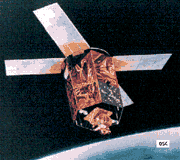SeaStar
SeaWiFS
 The SeaStar satellite carries the SeaWiFS instrument which is designed to monitor the color of the world's oceans. Various ocean colors indicate the presence of different types and quantities of marine phytoplankton, which play a role in the exchange of critical elements and gases between the atmosphere and oceans. The satellite will monitor subtle changes in the ocean's color to assess changes in marine phytoplankton levels, and will provide data to better understand how these changes affect the global environmental and the oceans' role in the global carbon cycle and other biogeochemical cycles. Complete coverage of the Earth's oceans will occur every two days. The NASA sponsored mission was contracted as a "data buy" from a Orbital Sciences Corporation, who will build, launch, and operate the satellite, and then sell data from the satellite to NASA. NASA will retain all rights to data for research purposes,
while will OSC retain all rights for commercial and operational purposes. The mission is a
follow on to the Coastal Zone Color Scanner (CZCS).
The SeaStar satellite carries the SeaWiFS instrument which is designed to monitor the color of the world's oceans. Various ocean colors indicate the presence of different types and quantities of marine phytoplankton, which play a role in the exchange of critical elements and gases between the atmosphere and oceans. The satellite will monitor subtle changes in the ocean's color to assess changes in marine phytoplankton levels, and will provide data to better understand how these changes affect the global environmental and the oceans' role in the global carbon cycle and other biogeochemical cycles. Complete coverage of the Earth's oceans will occur every two days. The NASA sponsored mission was contracted as a "data buy" from a Orbital Sciences Corporation, who will build, launch, and operate the satellite, and then sell data from the satellite to NASA. NASA will retain all rights to data for research purposes,
while will OSC retain all rights for commercial and operational purposes. The mission is a
follow on to the Coastal Zone Color Scanner (CZCS).
Spacecraft
Nadir pointing. 3-axis stabilized to 0.5 deg with 0.08 deg knowledge using 2 momentum
wheels, torque rods. Attitude determination via redundant sun sensors, horizon sensors,
and magnetometers. Hydrazine propulsion using four 1-lbf thrusters is used for orbit
raising and orbit maintenance. Nitrogen propulsion system provides satbilization during launch. Downlink using L-Band at 665.4 kbps, and S-Band at 2 Mbps. Uplink using S-Band at 19.2 kbps. Redundant GPS receivers for orbit determination. Four deployed solar panels with zenith-facing cells and two body-mounted side-facing solar panels produce 165 watts orbit-average after 5 years. 160 MBytes solid state recorder.
Payload
Only one instrument is carried: the Sea-viewing Wide Field-of-view Sensor (SeaWiFS). Consisting of an optical scanning telescope and an electronics module, SeaWiFS will image the Earth's oceans in 8 frequency bands.
Band Center Wavelength (nm) Bandwidth 1 412 20 2 443 20 3 490 20 4 510 20 5 555 20 6 670 20 7 765 40 8 865 40
The scanning telescope rotates at six revolutions per second in the cross-track direction to provide scan coverage with a spatial resolution of 1.13 km.| Country of Origin | United States |
| Customer/User | NASA |
| Manufacturer(s) | Orbital Sciences, Hughes |
| Launch | Planned for 1996-97 on Pegasus XL from WTR |
| Orbit | 705 km, circular, sun-synchronous (noon-midnight) |
| Design Life | 5 years |
| Related Sites | SeaStar / SeaWiFS site at GSFC |
Information in The Mission and Spacecraft Library is provided without warranty or guarantee. USE AT YOUR OWN RISK.